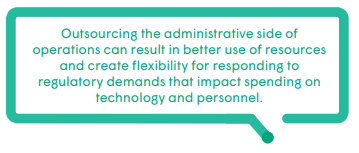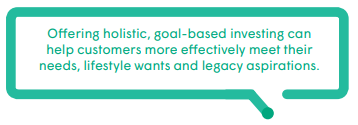Thought Leadership
Three Key Business Outcomes for Managing Your Wealth Services
April 02, 2018
The wealth management landscape is changing at lightning speed, driven by demographics, technology and competition. The biggest generational shift has already begun, with an estimated $30 trillion of wealth transferring down over the next several decades1. Technological factors – like smartphone penetration, increased app usage and the demand for anytime, anywhere access – are raising client expectations for their wealth managers. A well-primed market with an annual growth rate of 4.7 percent through 20212 is rapidly fueling competition from traditional and nontraditional service providers alike.
That’s why it’s important to prioritize the initiatives that can support and accelerate institutions’ ability to run, connect, and grow their businesses. That is, run operations more efficiently, connect more meaningfully with an evolving customer base, and invest in new growth strategies.
Run your wealth and trust operations more efficiently
For years, financial institutions have done their best to employ the latest in analytics, automation and new utility models to achieve the highest level of efficiency to their operations, yet they continue to struggle with funding the initiatives that could fuel top-line growth. That’s because the growth-oriented investments they would like to make are often redirected to address critical, and at times, unplanned activities such as regulatory compliance, fraud, cybersecurity threats and processes that are not strategic for the institution.
One cost-reduction strategy that institutions often overlook is outsourcing. It relieves firms of handling processes that are important, even vital, but not strategic, such as infrastructure, information security, application management and process automation. The right provider can help institutions implement best practices, including advanced automation and data management across the transaction life cycle. By collaborating with a provider with in depth knowledge of the market and access to the right proprietary technology, institutions can minimize exposure to regulatory distractions and gain improved operational performance.
This enables institutions to run operations cost-effectively by freeing them from the day-to-day routines of managing processes. It also provides a new organizational culture for innovation, one that allows firms to focus attention on workforce competencies, digital distribution and development of new technology to remain competitive and attract new customers.
Connect more meaningfully with your evolving customer base
More than 80 million people born between 1946 and 1964 (baby boomers) have already retired or will do so within the next 10 years, making this demographic a top priority for financial institutions offering wealth and trust services. With the wealth transfer still in its infancy, baby boomers control nearly $18 trillion in investable assets and have the highest percentage allocated across retirement accounts and mutual funds. Investors over the age of 70 who possess assets greater than $10 million remain the most influential group for wealth transfers3. However, this power is shifting to millennials (age 26 – 36) and Gen Xers (age 37 – 51), because they will soon inherit the biggest transfer of wealth, making them the most profitable and sought after demographics.
FIS™ brands this new supersegment of higher-income Gen Xers and senior millennials as “Gen MX” in the 2017 FIS PACE Report. The study confirms that three- quarters of Gen MX handle their financial transactions via online and mobile channels, their expectations having been shaped by other digital interactions in their personal and professional lives. This clearly demonstrates the need for anywhere, anytime access to accounts through digital means, with consistent account information at all points of contact, delivered simply and securely.
Gen MX is now in the driver’s seat. Many firms are requesting more holistic views across common data and interactive solutions to deepen relationships and deliver what Gen MXers are looking for: an improved, simpler customer experience. Service-oriented platforms that provide data aggregation from the back office to the front office feed engagement with tools such as user-friendly investor portals and digital advice that ensure a level of comfort and ease for clients when dealing with relationship managers.
Performance across customer service metrics, customization of products and services, mobile delivery, responsiveness and transparency are critical operational principles to connect meaningfully with clients. By understanding the mindset and motivation of this blended Gen MX group, firms can move toward digital networks and emerging financial technologies to increase time to market, stickiness and loyalty.

Invest in growth strategies through innovation and advice
The wealth management industry is surging and showing no signs of growth slowing down. This represents a huge business opportunity for financial institutions. Research suggests U.S. household assets will increase to over $140 trillion by 2030, of which nearly $64 trillion will be in investable financial assets. This means that in 2030, between $150 billion and $240 billion in wealth management fees could be up for grabs4.
While predictions only give a snapshot of the underlying story, when combined with a deeper understanding of the needs and behavioral patterns of the various generations, it provides insight for new ideas to capitalize on this potential growth and more profitable ways to offer services.
The FIS PACE Report shows that, while some providers are largely meeting their expectations, they still have untapped areas that are important to building relationships and trust. The ability to offer products tailored to value-conscious behavior and how customers buy products and services may force a revamp of long-entrenched operating models and how financial advice is provided to help achieve customers’ financial goals. The report also shows that up to half of consumers will turn to their primary financial institution for advice and lending to support their life events. This presents real opportunities for those primary financial institutions to become – or remain – first in the minds of investors. Expertise and understanding of wealth preservation and development is passed from generation to generation and cultivated and improved through long-standing relationships with their financial providers.
Wealth firms are adopting unified technologies to support a dynamic customer experience and provide simplicity.
Wealth managers no longer view their customers’ financial lives as transaction-driven, but rather are focusing on how to align their investments to help customers’ achieve their important life goals. Life events such as retiring, sending kids to college or buying a vacation home are taking precedent over reaching an arbitrary dollar amount in savings and investment accounts.
Considering the inevitable impact of the emerging wealth transfer, focusing on wealth and advisory services will likely prove lucrative. Holistic wealth managers that take an advisory approach driven by life events will deliver genuine added value for their clients. Embedding goal-based investing and strong digital advice technology solutions into their core advice offerings may become imperative for full service providers, smoothing the way for profitable business model design.
Closing the gap through holistic wealth servicing
Wealth managers are optimistic about the outlook of the industry; however, this is tempered by concerns to execute their ambitions, as they are acutely aware of the need to reposition their operational capabilities to drive growth. As market potential increases, so will new players – often well-funded – looking for market access. Traditional providers are stepping up their game to retain clients and attract new business, while nontraditional newcomers are luring tech-savvy investors with digital technologies. At the same time, customers demand bespoke solutions and access to information – all at a lower cost.
With all these forces in play, financial institutions are rethinking traditional business models and looking to reposition themselves for growth, focused on how to evolve new technologies, processes and people to drive value. The route to growth will take a variety of paths. Some will look to unlock growth by outsourcing noncore functions, while others will look to launch digital strategies expanding their advisory distribution with digital advice platforms. Ultimately, the competitive advantage will come down to cost, service and delivery of a dynamic customer experience.
Fast-growing companies have already moved past the need to do everything in-house. They frequently adopt a holistic approach that focuses on deriving value by investing in unified wealth management platforms that combine outsourcing across their business, allowing them to deliver front office technology to wealthy clients. This type of comprehensive model provides a solid foundation to run operations efficiently, allows time to explore emerging technology and differentiates the customer experience – all key business components to run, connect and grow a successful wealth management practice.

About FIS Wealth and Retirement
FIS' Wealth and Retirement business provides end-to-end solutions and services designed to help financial institutions and wealth advisors run their business more profitably, connect with their clients and grow their business. Customers have unparalleled control over their business model, with the ability to select the deployment option and solution suite that best fits their business needs. From client acquisition and communication, transaction management, risk and compliance, portfolio management, retirement plan administration and reporting, our solutions can be deployed as stand-alone products, part of a unified platform or in an outsourced environment.
About the 2017 FIS PACE Report
The PACE Report’s research was comprised of 1,000 individual customer surveys in each of the eight focus countries. Surveys were conducted online with individuals aged 18 – 75 who have a checking or equivalent account with a financial institution and who have financial decision making authority within their households. Questions were designed to minimize cross-cultural biases, where feasible; for scalar questions, normalization procedures were used in the analysis to mitigate bias. Surveys also were targeted to meet age and gender demographics for each country.
The global report, supported by country-specific infographics, can be downloaded from http://closethegaps.fisglobal.com.
About FIS
FIS is a global leader in financial services technology, with a focus on retail and institutional banking, payments, asset and wealth management, risk and compliance, consulting and outsourcing solutions. Through the depth and breadth of our solutions portfolio, global capabilities and domain expertise, FIS serves more than 20,000 clients in over 130 countries. Headquartered in Jacksonville, Florida, FIS employs more than 53,000 people worldwide and holds leadership positions in payment processing, financial so ware and banking solutions. Providing software, services and outsourcing of the technology that empowers the financial world, FIS is a Fortune 500 company and is a member of Standard & Poor’s 500® Index. For more information about FIS, visit www.fisglobal.com
1 HTTPS://WWW.CNBC.COM/2016/06/15/THE-GREAT-WEALTH-TRANSFER-HAS-STARTED.HTML
2 EY WEALTH MANAGEMENT OUTLOOK — 2017
3 THE NEGLECTED GENERATION; CERULLI 2017
4 THE FUTURE OF WEALTH IN THE UNITED STATES; DELOITTE